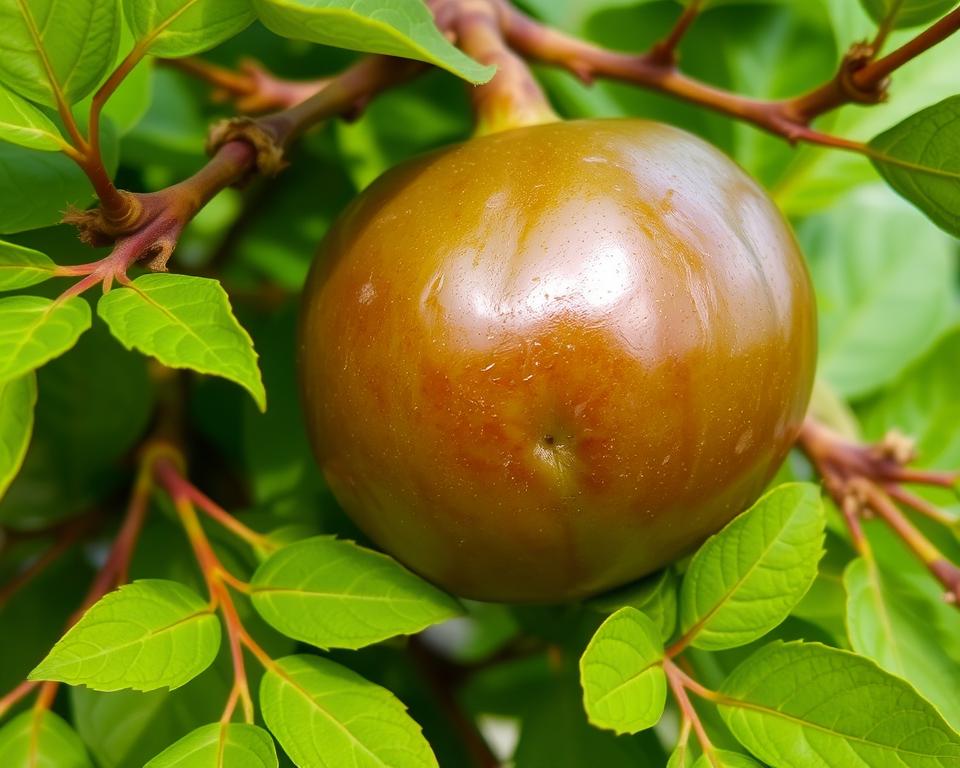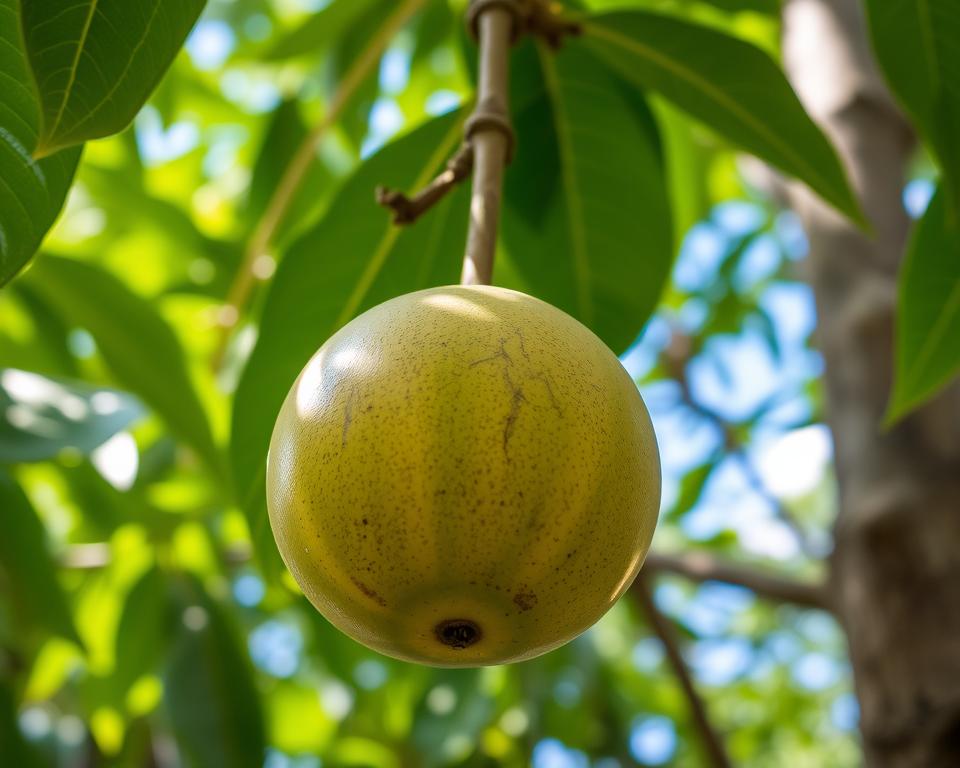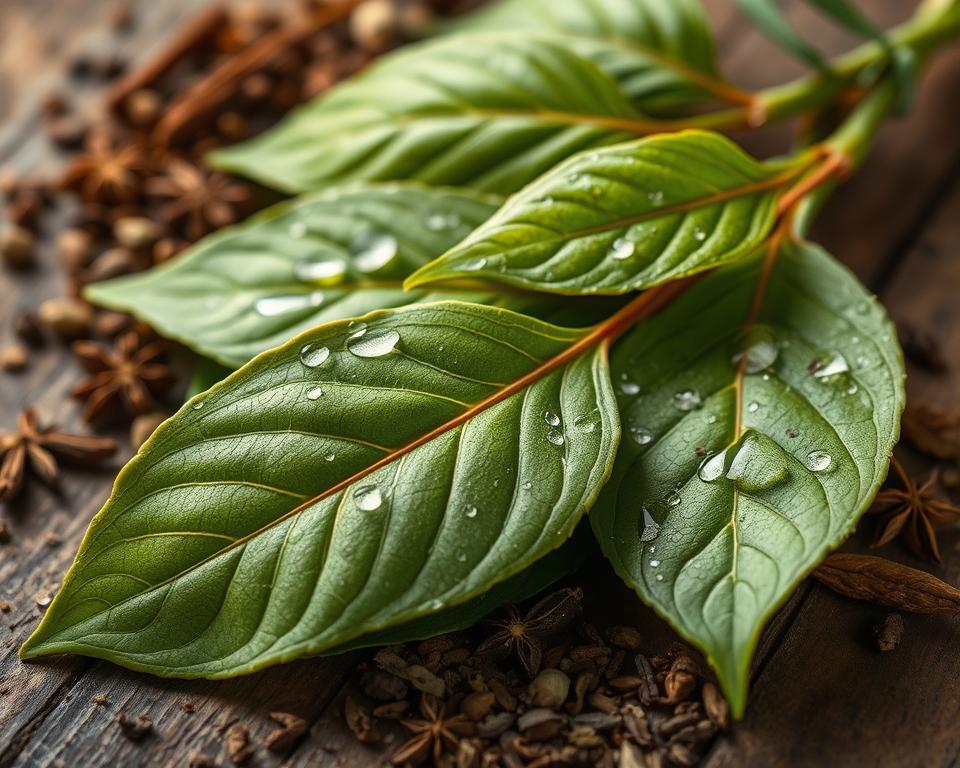Indian gooseberry, also known as amla or Emblica officinalis, is a superfruit with deep roots in Ayurvedic medicine. It’s packed with nutrients and is known for its health benefits. These benefits include boosting immunity and supporting skin and hair health. Learn about this ancient treasure and how to use it daily.
Read interesting things at : tosawakan
Key Takeaways
- Indian gooseberry, or amla, is a nutrient-dense superfruit with a long history in Ayurvedic medicine.
- This berry is rich in antioxidants and essential vitamins, including vitamin C, making it a powerful tool for overall health.
- Indian gooseberry offers a wide range of benefits, from supporting skin and hair health to aiding digestion and blood sugar management.
- Incorporating amla into your diet or supplement routine can provide a natural boost to your well-being.
- Explore the versatile culinary uses of Indian gooseberry and consider adding it to your daily routine.
Unleashing the Powerhouse of Indian Gooseberry
The Indian gooseberry, also known as amla, amalaki, or dhatriphala, is a true superfruit. It has been valued in Ayurvedic medicine for centuries. This small, green berry, known as Emblica officinalis, comes from the Indian subcontinent. It has a great nutritional profile.
An Ancient Ayurvedic Treasure
In ancient Ayurvedic traditions, the Indian gooseberry was seen as a healing agent. It was used to restore health and boost vitality. For thousands of years, it has been a key part of Ayurvedic practices in India.
Packed with Essential Vitamins and Minerals
The Indian gooseberry is amazing because of its nutrition. It’s full of important vitamins and minerals. These include:
- Vitamin C: Amla has a lot of vitamin C, even more than oranges.
- Vitamin A: It’s great for beta-carotene, which turns into vitamin A in the body.
- Minerals: It has iron, calcium, and phosphorus, which are good for health.
This makes the Indian gooseberry a superfruit. It offers many health benefits.
Indian Gooseberry: The Vitamin C Powerhouse
Indian gooseberry, also known as amla, is a fruit packed with vitamin C. It has more vitamin C than an orange, making it a superfruit. This fruit is full of antioxidants and helps boost your immune system.
Vitamin C is key for our health. It supports the immune system, helps with skin and hair health, and fights free radicals. Eating Indian gooseberry means you get lots of benefits from this vitamin C powerhouse.
“Indian gooseberry is a true vitamin C superstar, with its exceptional nutrient profile making it a versatile and valuable addition to any healthy diet.”
Amala is not just high in vitamin C. It also has vitamins A, E, iron, and calcium. These nutrients make Indian gooseberry great for your health.
You can eat amla fresh, as juice, or as supplements. Adding this vitamin C powerhouse to your daily life can boost your health.
Antioxidant-Rich Berry for Optimal Health
Indian gooseberry, or amla, is more than just a great source of vitamin C. It’s also packed with antioxidants. This antioxidant-rich berry is full of polyphenols, flavonoids, and other antioxidants. They work hard to fight off harmful free radicals and reduce oxidative stress in the body.
This fruit helps protect cells and supports overall health. Its high antioxidant levels make it a key player in fighting free radicals and oxidative stress. These issues are linked to many chronic health problems.
Combating Free Radicals and Oxidative Stress
Free radicals are unstable molecules that harm cells, causing oxidative stress and inflammation. This can lead to health issues like:
- Cardiovascular disease
- Neurodegenerative disorders
- Certain types of cancer
- Premature aging
Eating Indian gooseberry, or amla, regularly can help your body fight these free radicals. It keeps cells healthy and lowers the risk of oxidative stress-related diseases.
Revitalizing Hair and Skin with Amla
Indian gooseberry, or amla, is more than a superfruit for your health. It’s also great for your skin and hair. Its high vitamin C, antioxidants, and anti-inflammatory properties make it a strong hair and skin tonic. In Ayurvedic traditions, amla is used to help hair grow, stop hair from turning gray, and make skin look better.
Amla is great for your hair because it helps it grow and keeps it from turning gray early. The vitamin C and antioxidants in amla fight off free radicals and stress that can cause hair loss and color changes. Using amla-based hair oils or masks can make hair follicles stronger, reduce dandruff, and make hair soft, shiny, and lively.
For your skin, amla is full of nutrients. It can calm down redness and irritation, and its vitamin C can make skin tone even and boost collagen for a younger look. Amla can also help with skin problems like acne, eczema, and dark spots because of its natural cleaning and tightening effects.
| Benefits of Amla for Hair and Skin |
|---|
|
Adding amla-based products to your hair and skin care can bring out the best in this ancient Ayurvedic gem. Whether it’s hair oils, masks, or serums, amla is a natural way to make your hair and skin look healthy and glowing.
Aiding Digestion and Detoxification
The amazing Indian gooseberry, also known as amla, does more than just help our skin and hair. This superfruit is key in keeping our digestive health and detoxification on track.
Harnessing the Benefits of Amla for Gut Health
Amla is famous for its ability to help with bowel movements and getting rid of toxins. It’s packed with fiber, which is great for a healthy gut. This fiber also helps good gut bacteria grow, which is vital for gut health.
| Digestive Benefits of Amla | Detoxification Properties of Amla |
|---|---|
|
|
Using amla can boost your digestive health and help with detoxification. This leads to better overall health and well-being.
Blood Sugar Management with Indian Gooseberry
Research shows that the Indian gooseberry, or amla, could be key to better blood sugar control. This ancient fruit is full of compounds like gallic acid and ellagic acid. These have been found to help insulin work better and keep blood sugar stable.
Studies suggest adding Indian gooseberry to your diet can help manage blood sugar naturally. It can:
- Improve insulin resistance and enhance glucose uptake by cells
- Regulate the absorption and utilization of carbohydrates
- Support healthy pancreatic function and insulin production
- Modulate inflammatory pathways that can contribute to blood sugar imbalances
For those wanting to keep their blood sugar in check, amla could be a great choice. Its antioxidants and anti-inflammatory effects make it a natural option for managing blood sugar without synthetic drugs.
| Bioactive Compound | Mechanism of Action |
|---|---|
| Gallic Acid | Enhances insulin sensitivity and glucose uptake by cells |
| Ellagic Acid | Modulates inflammatory pathways and supports pancreatic function |
| Vitamin C | Supports immune function and antioxidant defenses |
Using Indian gooseberry could be a natural way for people with blood sugar issues to improve their health and well-being.
Boosting Immunity and Fighting Infections
Indian gooseberry, also known as amla, is packed with nutrients that help boost the body’s defenses. It’s full of vitamin C and antioxidants. These make it great for supporting the immune system and fighting infections.
Amla’s Anti-Inflammatory Properties
Indian gooseberry is also known for its anti-inflammatory effects. It’s loaded with polyphenols and other compounds that reduce inflammation. This can help prevent and manage many health issues, from chronic diseases to acute infections.
Research shows that Indian gooseberry antioxidants can neutralize free radicals. These are harmful to our health and cause inflammation. So, amla is a natural way to fight inflammation at its source.
| Benefits of Indian Gooseberry | Scientific Evidence |
|---|---|
| Boosts Immunity | High in vitamin C, which supports immune function |
| Fights Infections | Antioxidant and anti-inflammatory properties help combat infections |
| Reduces Inflammation | Rich in polyphenols that can help mitigate inflammation |
Using Indian gooseberry can help keep your immune system strong. It can also lower the risk of infections and inflammatory conditions.
Weight Management and Indian Gooseberry
Indian gooseberry, or amla, is known for its great nutrition and health benefits. It might also help with weight management. Studies show that its compounds like gallic acid and ellagic acid could help with metabolism and fat burning.
The Indian gooseberry is also high in fiber. Fiber can make you feel full and reduce overeating. This makes amla a good choice for those trying to manage their weight.
“Incorporating Indian gooseberry into your diet may provide a natural and holistic approach to supporting your weight management goals.”
To use amla for weight management, try it in different ways like fresh fruit, juices, powders, or supplements. Always talk to a healthcare professional before making any big changes to your diet. They can make sure it fits your health goals and needs.
Cardiovascular Benefits of Amla
Indian gooseberry, or amla, is more than just a fruit. It’s packed with nutrients that are great for your heart. Studies show it can help keep your heart healthy and lower the risk of heart diseases.
Amla is known for its effect on cholesterol. It has lots of antioxidants that can lower bad cholesterol and triglycerides. At the same time, it can keep or raise good cholesterol levels. This can make your heart work better.
Also, eating amla regularly might help lower your blood pressure. Its compounds like flavonoids and tannins can help control blood pressure. This makes it a good choice for keeping your heart in good shape.
Amla can also help prevent other heart problems. Its anti-inflammatory effects and ability to fight free radicals can protect your heart. This is important because oxidative stress can lead to heart diseases.
Adding Indian gooseberry to your diet or supplements can be good for your cardiovascular health. Whether you eat the fruit or take amla supplements, it’s a natural way to keep your heart healthy.

| Cardiovascular Benefit | Mechanism of Action |
|---|---|
| Cholesterol Regulation | Reduces LDL (bad) cholesterol and triglycerides, while maintaining or increasing HDL (good) cholesterol levels |
| Blood Pressure Regulation | Helps lower blood pressure through its bioactive compounds, such as flavonoids and tannins |
| Oxidative Stress Reduction | Scavenges free radicals and exhibits anti-inflammatory properties, protecting the heart from oxidative damage |
Incorporating Indian Gooseberry into Your Diet
Adding the powerful Indian gooseberry, also known as amla, to your daily meals is easy and beneficial. This fruit fits well in many dishes, making it easy to add to any meal or snack.
Versatile Culinary Uses of Amla
Amla has a unique taste that works well in both sweet and savory dishes. You can enjoy it fresh, dried, or as juices, pickles, chutneys, and preserves. It’s also great in salads, curries, baked goods, and smoothies. This lets you easily add the dietary uses and culinary uses of amla and indian gooseberry to your meals.
Start your day with a refreshing smoothie or juice that includes amla. It’s also a tasty addition to vegetable curries or stir-fries. For something different, try adding amla to baked goods like muffins, scones, or jams and preserves.
| Culinary Use | Preparation |
|---|---|
| Fresh | Eaten raw or added to salads |
| Dried | Snacks, teas, or powders for cooking |
| Juices | Blended with other fruits and vegetables |
| Pickles | Fermented or brined amla preserves |
| Chutneys | Savory condiments made with amla |
| Preserves | Jams, jellies, and marmalades |
By using amla and indian gooseberry in your cooking, you can enjoy their dietary uses. This way, you get to enjoy the fruit’s health benefits in tasty dishes.
Indian Gooseberry Supplements and Dosage
For those looking for a stronger Indian gooseberry source, supplements with amla extract or powder are a good choice. It’s key to follow the dosage instructions on the label and talk to a healthcare expert. This is especially true if you have health issues or are on other medications.
The right amount of Indian gooseberry supplements depends on your age, health, and needs. Usually, you should take 500 to 1,000 milligrams a day. This amount is often split into two or more doses.
Remember, the quality and strength of Indian gooseberry supplements differ across brands. So, it’s important to buy from trusted sources. Always check the labels to make sure you’re getting a quality product.
| Supplement | Typical Dosage | Potential Benefits |
|---|---|---|
| Amla Powder | 500-1,000 mg per day | Antioxidant support, immune system enhancement, and cardiovascular health promotion |
| Amla Extract | 500-1,000 mg per day | Concentrated source of Indian gooseberry benefits, including improved digestion and blood sugar management |
Always talk to a healthcare professional before starting any new supplements, especially if you have health issues or are on medications. They can help you choose the right Indian gooseberry supplement and dosage for your needs.
Potential Side Effects and Precautions
The Indian gooseberry, also known as amla, is usually safe and good for you. But, it’s good to know about possible side effects and how to use it safely. Some people might get mild stomach issues like belly pain or diarrhea if they eat too much of it or its supplements.
Before adding Indian gooseberry or amla to your diet, talk to a doctor. This is especially true if you have health problems or are on medication. Indian gooseberry might change how some medicines work or cause bad reactions.
| Potential Side Effects | Precautions |
|---|---|
|
|
Being careful about the side effects and precautions helps you enjoy the health benefits of Indian gooseberry or amla safely. This way, you can avoid any problems.

“Moderation is key when it comes to consuming Indian gooseberry or amla. It’s a powerful superfruit, but as with any supplement or natural remedy, it’s important to use it responsibly and under the guidance of a healthcare professional.”
Conclusion
Indian gooseberry, or amla, is a superfruit with a long history in Ayurvedic medicine. It’s packed with nutrients and is known for many health benefits. These benefits include boosting immunity, supporting skin and hair health, aiding digestion, and managing blood sugar levels.
Adding Indian gooseberry to your daily routine can help you feel better overall. You can eat it fresh, take supplements, or use it in recipes. It’s full of vitamins, minerals, and antioxidants that are good for your health.
By using Indian gooseberry, you can improve your health and feel more alive. It’s a powerful way to take care of your body, mind, and spirit.
In conclusion, Indian gooseberry, or amla, is a superfruit that should be part of your health plan. It’s an ancient Ayurvedic remedy that can lead you to better health, beauty, and well-being.










